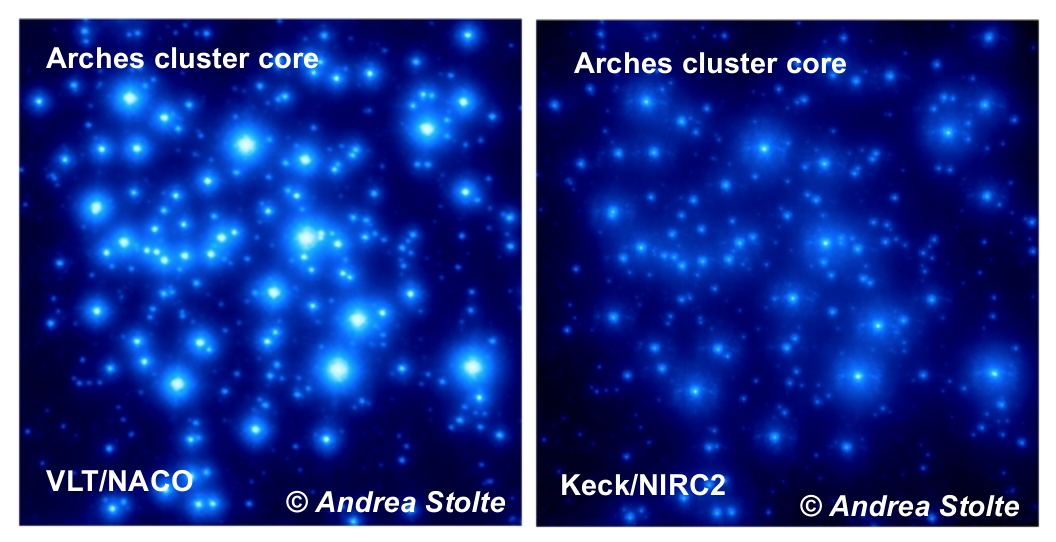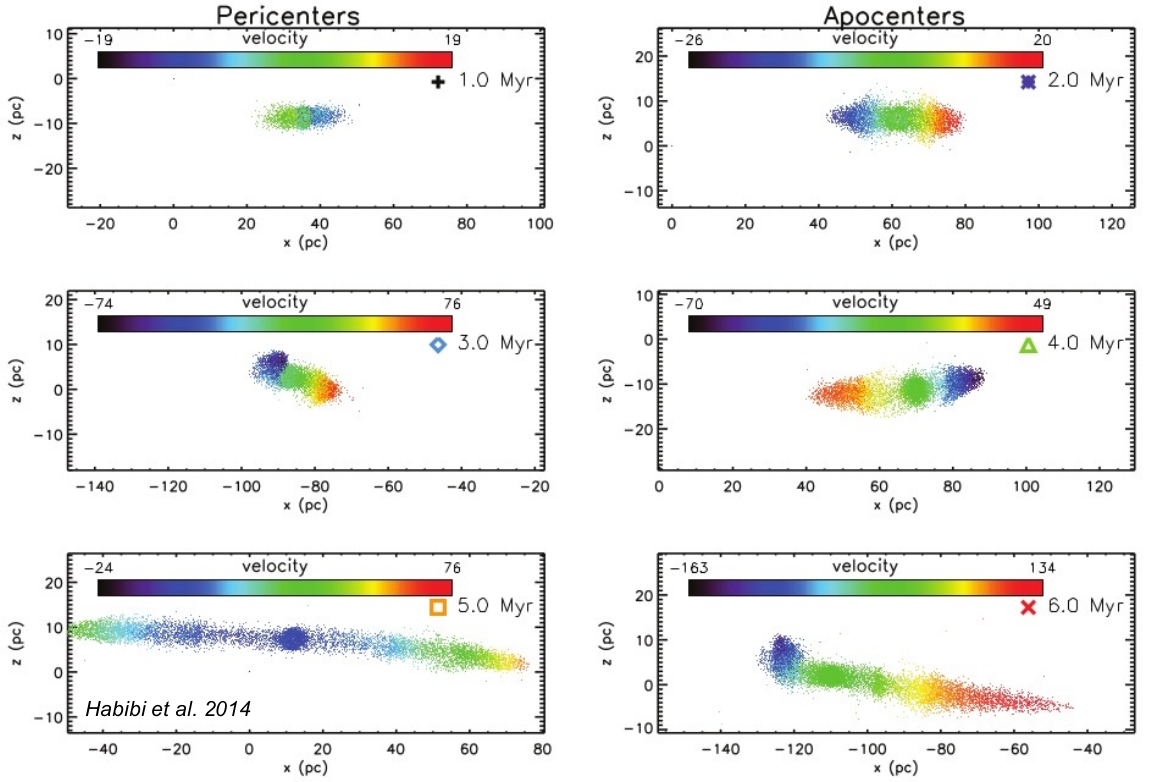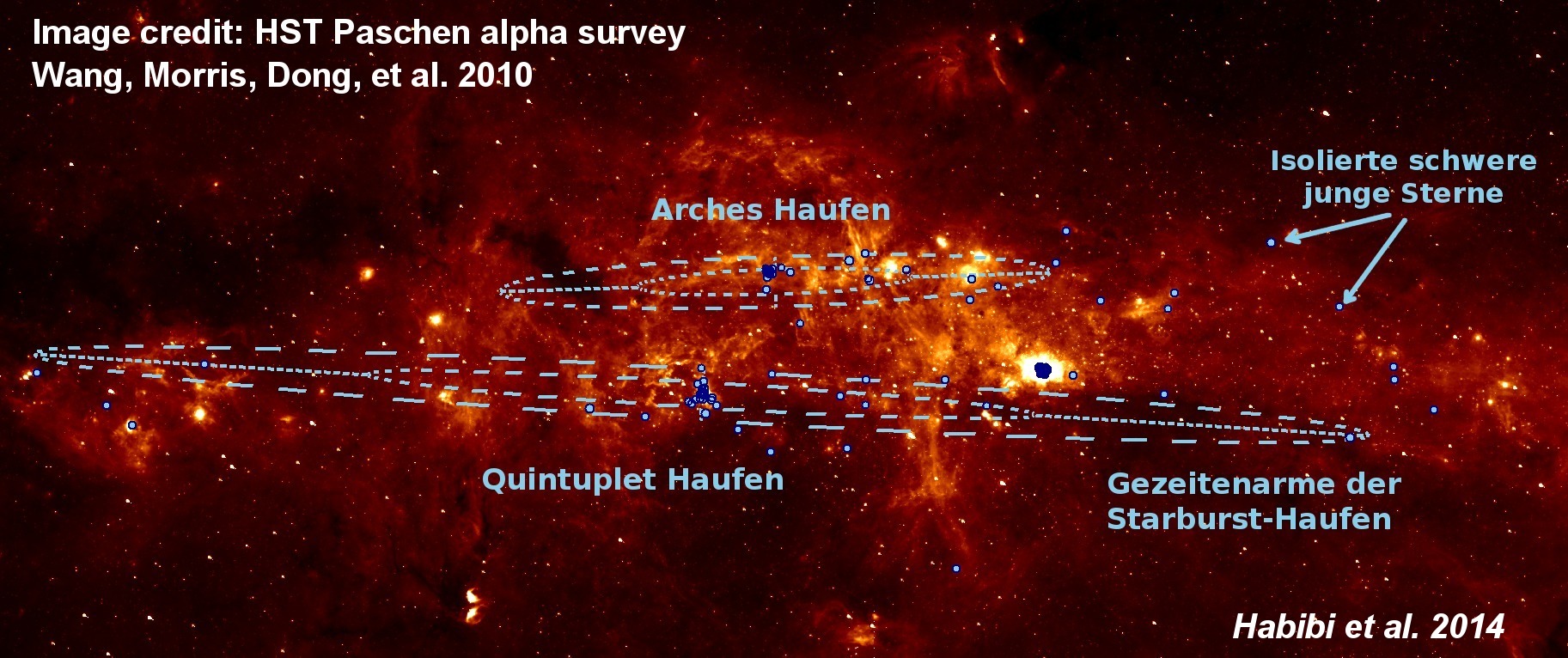The orbital motion of the Arches & Quintuplet clusters
With the measurement of the proper motion, we could begin to understand the cluster's evolution in the Galactic tidal field. One of the aspects that could be compared to observations for the first time was:
- How are starburst clusters affected by tides on their orbits?
- Do Galactic center clusters contribute significantly to the known field population of high-mass stars?
- The measurement of the proper motion of the Arches and Quintuplet clusters, combined with their known radial velocities, allowed the calculation of the cluster orbits. With the known projected location of the Arches and the Quintuplet on the sky, the only free parameter in these simulations is the line-of-sight distance. The orbital motion provides clues on the formation of the clusters, on their rapid, and disruptive, evolution in the Galaxy’s tidal field, and on their final fate.
Galactic center clusters evolve rapidly on their orbits
It is known since more than a decade that Galactic center clusters disperse much more rapidly than their spiral arm counterparts. Specific simulations for the Arches cluster were carried out by several groups (Kim et al. 1999, 2000, 2003, Portegies Zwart et al. 2000, 2002, to name only a few). However, the early observations covered mostly the cluster core of the Arches, and it was difficult to constrain cluster parameters from the comparison between the observed evidence and the models.Constraining the initial mass function and cluster density
In Harfst et al. 2010, we have used a detailed statistical analysis between the observed distribution of high-mass stars and the modelled distribution over the same mass range and cluster area. From these models, the cluster properties at the time of cluster birth could be more stringently constrained. In particular, Stefan Harfst found that no deviating initial mass function is necessary to explain the present-day overdensity of high-mass stars in the cluster core. In her thesis, Maryam Habibi was able to extend this result to the outer cluster area, where the steepening of the mass function provides the final confirmation of the model predictions (Habibi et al. 2013). She also used the dynamical simulations to constrain the tidal dispersal of high-mass stars into the field, as discussed below.The proper motion as the prerequisite for realistic models
With the measurement of the proper motion of both the Arches and the Quintuplet cluster, we were able to derive a realistic estimate of the cluster orbits in the Galactic center tidal field for the first time. In all previous simulations, the orbital velocity was unknown, and the line-of-sight distance of the clusters is also poorly constraint. The derivation of the cluster orbits confirms several assumption on cluster formation in the central molecular zone of the Milky Way:- Arches & Quintuplet likely formed in the central 200pc
- they might both have formed near the point where molecular clouds stream into the central molecular zone
-
the clusters have possibly formed in a cloud-cloud collision:
this scenario might explain their high orbital velocity -
the orbital velocity provides stringent constraints on the
dynamical and tidal evolution
of the Arches & the Quintuplet in the Galactic center tidal field
Orbits of the Arches & Quintuplet clusters
The proper motion of the Arches cluster was derived from these
two images obtained with the VLT/NAOS-CONICA and the Keck/NIRC2
adaptive optics instruments:
The two diagrams below show possible orbits of the Arches and Quintuplet
clusters around the Galactic center.
The distance to both clusters is not precisely known. This means that their
exact location in the central tidal field cannot be calculated. The orbits
are therefore modelled at a range of likely line-of-sight distances. These
distances are given on the y-axis with respect to the center of the Milky Way
(the supermassive black hole and the suspected center of the gravitational
field created by the ensemble of stars and clouds in the central molecular
zone). The Quintuplet moves slightly slower than the Arches, hence it is
more effectively pulled towards the gravitational center and the orbits
appear squished. The Arches orbits are more extended because its fast velocity
helps the cluster to resist the gravitational forces.
Orbit simulation of the motion of the Arches cluster (left)
and the Quintuplet (right) in the Galactic center tidal field.
At these distances, the gravitational field is not dominated by the supermassive
black hole (indicated by a black dot at the origin), but by the ensemble
of stars and molecular clouds in the inner Galaxy, all orbiting the center
where the black hole resides.
The orbits are seen from above the Milky Way's disc, and the
location of the Sun and the Observer is at the bottom of each plane.
The small black triangles indicate possible birth places of both clusters.
The green arrows represent the orbital motion as observed today.
They are placed at the clusters' present-day projected location,
and dashed lines project each orbit into the future.
The red ellipse represents the innermost stable x2 orbit, the location
where many molecular clouds in the central molecular zone circulate.
A schematic view of the Arches & Quintuplet motions
This composite was assembled from near-infrared images in the
J, H, and K bands from 1.2 to 2.2 micrometers. The images are
courtesy of the UKIDSS Galactic plane survey (Lucas et al.~2008).
The brightest area at the lower left represents the immediate
environment of the supermassive black hole. This is the region
in the Milky Way with the highest density in stars outside of
dense cluster cores. The long arrow between the center and
the Quintuplet cluster illustrates the approximate location of
the Galactic plane (note the overdensity of stars around this line).
The two green arrows indicate the proper motion of the star
clusters. Both clusters fly outwards from the Galactic center and
away from the observer into the plane of the sky at the present
time. However, the present-day motion provides only a snapshot
of the cluster orbit, and both clusters will fling back around
the Galactic center eventually in a few million years.
A Galactic mystery: The formation of the Arches & the Quintuplet
Both clusters move too fast to be on one of the known circular or
spheriodal orbits of molecular clouds in the inner Galaxy. So far,
no formation scenario can fully explain the rapid motion of the cluster
and the orientation of its orbital vectors at the same time (see
Stolte et al. 2008 for a detailed discussion).
From the molecular clouds measured at radio wavelength, forming a cluster
with the dynamical properties especially of the fastest moving Arches cluster
seems almost unfeasible.
Tidal tails - a source for field stars ejected from Arches & Quintuplet
Our colleague and cluster enthusiast Stefan Harfst has modelled the
orbital motion of both clusters in the Galactic tidal field using the
observed orbital velocities as boundary conditions. Maryam Habibi emploid
these models to estimated the number of high-mass stars that might have
escaped into the field during the clusters lifetimes. She finds that
both clusters contributed high-mass stars to the field population and
that these escapers can explain the majority of isolated high-mass stars
with ages of a few million years (so-called Wolf-Rayet stars) in the
central molecular zone. Combining models and observations,
Maryam was able to solve a mystery - common star-formation scenarios
suggest that high-mass stars should form in clusters or groups, and
not in isolation. Yet, no common origin was previously known for these
isolated young massive stars. With the evaporation of high-mass stars
from the clusters' tidal tails, it has now become likely that they
formed in the same fashion as their siblings in the spiral arms -
in dense starburst clusters. The difference between the Arches and
Quintuplet clusters and the spiral arm starbursts lies in their very
rapid dynamical evolution in the strong Galactic center tidal field.
Simulated cluster orbits projected on the plane of the sky.
The top panel shows the time stamp of each 1 million year snapshot
at its orbital location. The bottom panels display the distribution
of simulated cluster stars and hence the appearance of the cluster
after tidally evolving in the central gravitational field for the
given time. Left panels are locations close to the cluster's perigalacticon,
right panels are locations close to apogalacticon.
The colours indicate how stars trail behind or proceed in front as they
become tidally dispersed and their velocities become increasingly distinct
from the cluster velocity. Note how the tidal tails start to stretch out
after a cluster age of about 4 million years.
This illustration from Maryam Habibi's
press release at the University of Bonn
shows the location of observed high-mass stars from
a survey conducted by Jon Mauerhan (2010ab). All light-blue circles
represent a Wolf-Rayet emission star, known to be massive and young.
These high-mass stars are found in the centers of each cluster, including
the young nuclear cluster surrounding the supermassive black hole,
where they are expected to form. The surprise was the finding of a large
fraction of these sources isolated in the field. The location of the
tidal tails of the best-fitting models of the Arches and the Quintuplet
clusters is indicated by the ellipses. The significant overlap between
the cluster tails and the isolated population suggests that many, if not
all, of these high-mass stars might originate from the known clusters
in the Galactic center. The models make stringent predictions for the
expected velocities of escapers. Hence, once the individual velocities
of these high-mass stars can be observed, their belonging to the tidal
population can be confirmed. A cluster origin of these young, massive stars
solves the mystery of their apparent "birth in isolation".
References:
Stolte, A., Hußmann, B., Morris, M. R., Ghez, A. M., Brandner, W., Lu, J. R., Clarkson, W. I., Habibi, M., Matthews, K. 2014:
The Orbital Motion of the Quintuplet Cluster---A Common Origin for the Arches and Quintuplet Clusters?
Astrophysical Journal, 789, 115
Stolte, A., Ghez, A. M., Morris, M., Lu, J. R., Brandner, W., Matthews, K. 2008:
The Proper Motion of the Arches Cluster with Keck Laser-Guide Star Adaptive Optics
Astrophysical Journal, 675, 1278
Habibi, M., Stolte, A., Harfst, S. 2014:
Isolated massive stars in the Galactic center: The dynamic contribution from the Arches and Quintuplet star clusters
Astronomy & Astrophysics, 566, A6
see also:
Dong, H., Wang, Q. D., Morris, M. R. 2012:
A multiwavelength study of evolved massive stars in the Galactic Centre
Monthly Notices of the Royal Astronomical Society, 425, 884
Mauerhan, J. C., Cotera, A., Dong, H., Morris, M. R., Wang, Q. D., Stolovy, S. R., Lang, C. 2010a:
Isolated Wolf-Rayet Stars and O Supergiants in the Galactic Center Region Identified Via Paschen-alpha Excess
Astrophysical Journal, 725, 188
Mauerhan, J. C., Muno, M. P., Morris, M. R., Stolovy, S. R., Cotera, A. 2010b:
Near-infrared Counterparts to Chandra X-ray Sources Toward the Galactic Center. II. Discovery of Wolf-Rayet Stars and O Supergiants
Astrophysical Journal, 710, 706
Mauerhan, J. C., Muno, M. P., Morris, M. 2007:
Discovery of Hot Supergiant Stars near the Galactic Center
Astrophysical Journal, 662, 574
Wang, Q. D., Dong, H., Cotera, A., Stolovy, S., Morris, M., Lang, C. C., Muno, M. P., Schneider, G., Calzetti, D.
HST/NICMOS Paschen-alpha Survey of the Galactic Centre: Overview
Monthly Notices of the Royal Astronomical Society, 402, 895
Stolte, A., Hußmann, B., Morris, M. R., Ghez, A. M., Brandner, W., Lu, J. R., Clarkson, W. I., Habibi, M., Matthews, K. 2014:
The Orbital Motion of the Quintuplet Cluster---A Common Origin for the Arches and Quintuplet Clusters?
Astrophysical Journal, 789, 115
Stolte, A., Ghez, A. M., Morris, M., Lu, J. R., Brandner, W., Matthews, K. 2008:
The Proper Motion of the Arches Cluster with Keck Laser-Guide Star Adaptive Optics
Astrophysical Journal, 675, 1278
Habibi, M., Stolte, A., Harfst, S. 2014:
Isolated massive stars in the Galactic center: The dynamic contribution from the Arches and Quintuplet star clusters
Astronomy & Astrophysics, 566, A6
see also:
Dong, H., Wang, Q. D., Morris, M. R. 2012:
A multiwavelength study of evolved massive stars in the Galactic Centre
Monthly Notices of the Royal Astronomical Society, 425, 884
Mauerhan, J. C., Cotera, A., Dong, H., Morris, M. R., Wang, Q. D., Stolovy, S. R., Lang, C. 2010a:
Isolated Wolf-Rayet Stars and O Supergiants in the Galactic Center Region Identified Via Paschen-alpha Excess
Astrophysical Journal, 725, 188
Mauerhan, J. C., Muno, M. P., Morris, M. R., Stolovy, S. R., Cotera, A. 2010b:
Near-infrared Counterparts to Chandra X-ray Sources Toward the Galactic Center. II. Discovery of Wolf-Rayet Stars and O Supergiants
Astrophysical Journal, 710, 706
Mauerhan, J. C., Muno, M. P., Morris, M. 2007:
Discovery of Hot Supergiant Stars near the Galactic Center
Astrophysical Journal, 662, 574
Wang, Q. D., Dong, H., Cotera, A., Stolovy, S., Morris, M., Lang, C. C., Muno, M. P., Schneider, G., Calzetti, D.
HST/NICMOS Paschen-alpha Survey of the Galactic Centre: Overview
Monthly Notices of the Royal Astronomical Society, 402, 895





